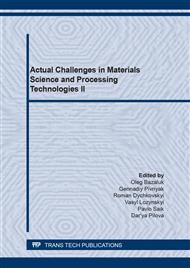[1]
Mavukwana, A. E. (2016). Development of a simulation model for gasification of South African solid waste: waste tyres and agricultural residue (Doctoral dissertation, University of Johannesburg).
Google Scholar
[2]
Oboirien, B.O., & North, B.C. (2017). A review of waste tyre gasification. Jour of Environ-mental Chemical Engineering, 5(5), 5169-5178. https://doi.org/10.1016/j.jece.2017.09.057.
DOI: 10.1016/j.jece.2017.09.057
Google Scholar
[3]
Van Staden, P.A.J. (2012). A feasibility study to establish the preferred environmentally-friendly utilisation option in respect of waste tyre materials in South Africa (Doctoral dissertation, Stellenbosch: Stellenbosch University).
Google Scholar
[4]
Portofino, S., Casu, S., Iovane, P., Russo, A., Martino, M., Donatelli, A., & Galvagno, S. (2011). Optimizing H2 Production from Waste Tires via Combined Steam Gasification and Catalytic Reforming. Energy & Fuels, 25(5), 2232-2241. https://doi.org/10.1021/ef200072c.
DOI: 10.1021/ef200072c
Google Scholar
[5]
Sempuga, B.C., Hausberger, B., Patel, B., Hildebrandt, D., & Glasser, D. (2010). Classification of Chemical Processes: A Graphical Approach to Process Synthesis to Improve Reactive Process Work Efficiency. Industrial & Engineering Chemistry Research, 49(17), 8227-8237. https://doi.org/10.1021/ie100288h.
DOI: 10.1021/ie100288h
Google Scholar
[6]
Sempuga, B.C., Hildebrandt, D., Patel, B., & Glasser, D. (2011). Work to Chemical Processes: The Relationship between Heat, Temperature, Pressure, and Process Complexity. Industrial & Engineering Chemistry Research, 50(14), 8603-8619. https://doi.org/10.1021/ie2004785.
DOI: 10.1021/ie2004785
Google Scholar
[7]
Sekwambane, B.P. (2012). Graphical Techniques to biomass gasification (Doctoral dissertation).
Google Scholar
[8]
Muvhiiwa, R.F., Lu, X., Hildebrandt, D., Glasser, D., & Matambo, T. (2017). Applying thermodynamics to digestion/gasification processes: the Attainable Region approach. Journal of Thermal Analysis and Calorimetry, 131(1), 25-36. https://doi.org/10.1007/s10973-016-6063-9.
DOI: 10.1007/s10973-016-6063-9
Google Scholar
[9]
Nkosi, N., & Muzenda, E. A review and discussion of waste tyre pyrolysis and derived products. In Proceedings of the world congress on engineering, 2, 2-4.
Google Scholar
[10]
Rowhani, A., & Rainey, T. (2016). Scrap Tyre Management Pathways and Their Use as a Fuel - A Review. Energies, 9(11), 888. https://doi.org/10.3390/en9110888.
DOI: 10.3390/en9110888
Google Scholar
[11]
Janajreh, I., & Raza, S.S. (2015). Numerical simulation of waste tyres gasification. Waste Management & Research, 33(5), 460-468. https://doi.org/10.1177/0734242x15573656.
DOI: 10.1177/0734242x15573656
Google Scholar
[12]
Ishida, M., & Chuang, C.C. (1997). New approach to thermodynamics. Energy Conversion and Management, 38(15-17), 1543-1555. https://doi.org/10.1016/S0196-8904(96)00216-6.
DOI: 10.1016/s0196-8904(96)00216-6
Google Scholar
[13]
Okonye, L.U.O. (2011). Performance targets for a chemical process using a graphical technique: A case study of the methanol synthesis process (Doctoral dissertation).
Google Scholar
[14]
Ngubevana, L.B. (2011). Attainable operating regions: Synthesis and analysis of gasification systems (Doctoral dissertation).
Google Scholar


